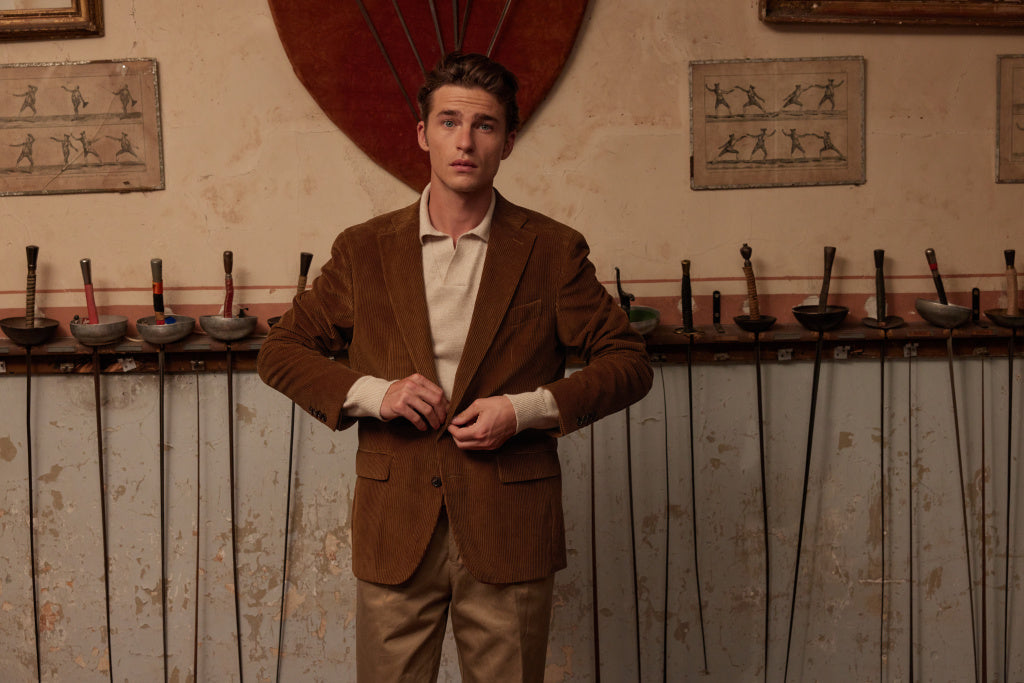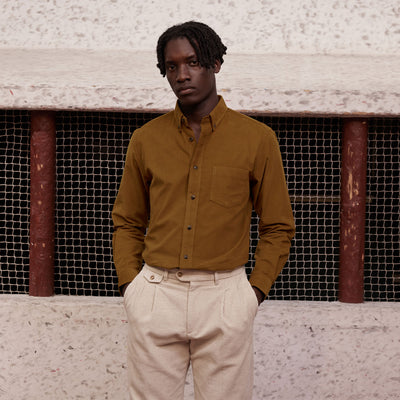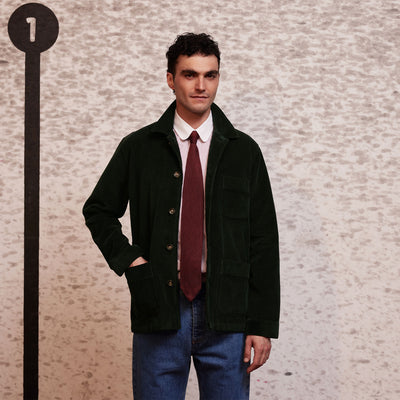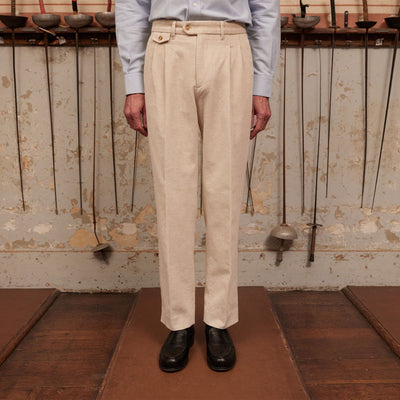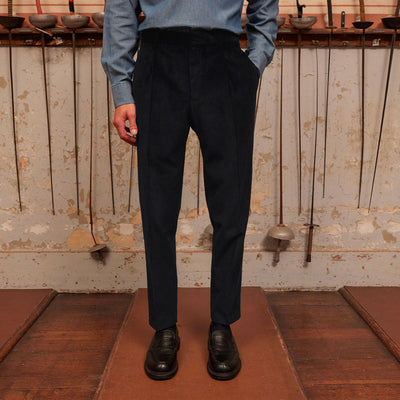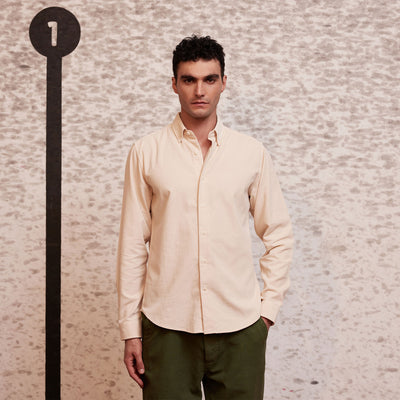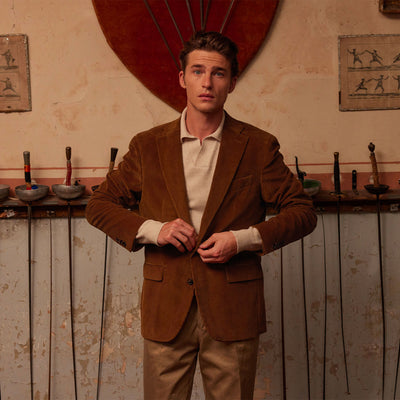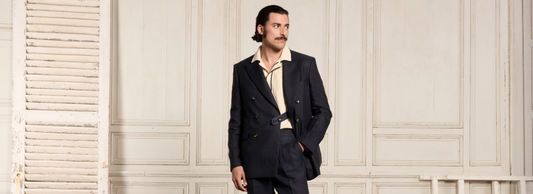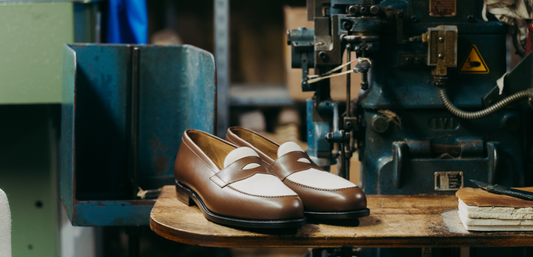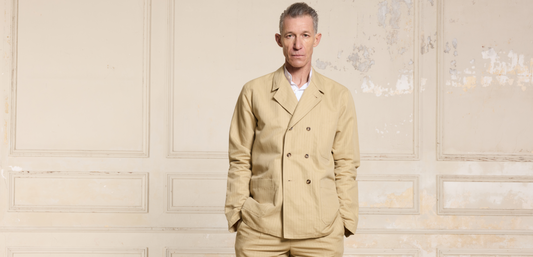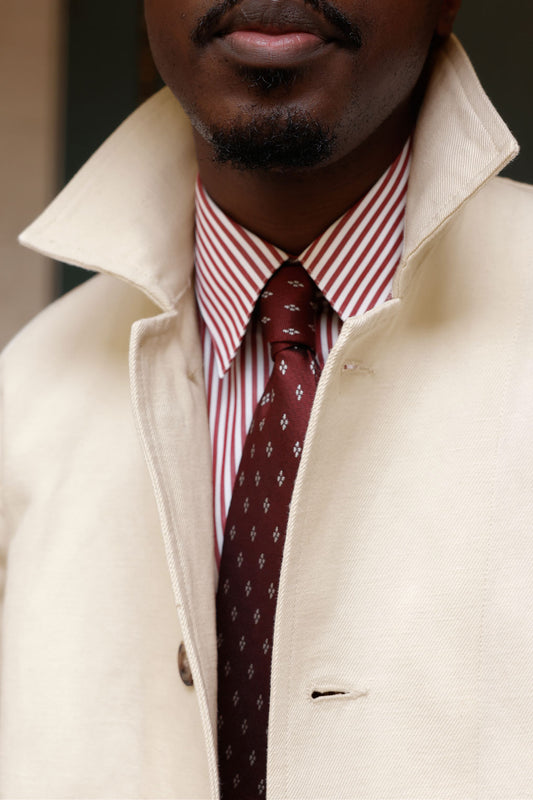A true icon of the '70s, corduroy velvet has returned to the forefront in recent years. After half a century spent in the shadow of unsightly stereotypes, this unique and warm fabric is now stepping back into the light, much to our delight.
As for us, neither its outdated airs nor its association with philosophy professors have diminished our passion for this exceptional fabric, to which we roll out the red carpet in each of our collections.
Today, we add an article to the list of these proofs of love. Here it is.
Corduroy Velvet, a Technical Feat
Before being a fabric with a wonderfully textured surface, corduroy velvet is a small wonder of inventiveness. It is made up of two distinct layers woven simultaneously on the same loom, separated by only a few millimeters. The operation is very impressive to watch and requires precision like that of a goldsmith.
Each of these fabrics has its own warp around which its own wefts zigzag (to form the ridges), and it is a third warp that is responsible for binding these two layers. Several thousand passes later, a sharpened blade separates the conjoined fabrics, leaving on the surface of each one the raised and bare fibers of the third warp.
A picture is worth a thousand words, so we offer you the one from the Stiff Collar blog, which is worth a thousand images itself.

You can see on either side the two layers of fabric, with their warps (orange) and their wefts (red and violet) respectively. Between them, the third warp (duck blue) makes the connection, awaiting the passage of the blade. Once passed, the bristling threads give corduroy velvet its deliciously tousled appearance.
The technical explanation is a bit complicated (without a bad pun), but you will have at least something to discuss when your raw work jacket receives 1,001 compliments.
The Many Faces of Velvet
As you've understood, velvet refers less to a raw material than to a weaving technique. Like denim or flannel, it is possible to work with various fibers. On the market, you can find corduroy velvet made of cotton, silk, wool, polyester, mohair, or any other blend.
If you're familiar with our commitment to a 100% natural wardrobe, you won't be surprised to find organic cotton velvets on our racks, combining the natural softness of this fiber with the characteristic tenderness of the fabric.
This season, we even innovated with a corduroy velvet composed of 74% cotton and 26% linen, offered by the French Maison Velcorex. An innovative blend for a clean line, a neat fall, and a touch full of authenticity.
Velvets: From Super-Light to Heavyweight
It's no longer a secret: the weight of fabrics varies according to the fiber used, the thickness of the selected threads, and the desired density. The same goes for corduroy velvet, which can be thicker or thinner depending on the garment you want to dress.
For our corduroy shirts, for example, these values range from 165 g/m2 for the camel model to 197 g/m2 for its burgundy variant.
Much heavier, our corduroy jackets and pants reach for some the 390 g/m2 mark. A higher weight, but also more in line with the requirements of outerwear.
Furthermore, the size of the ribs can change from one fabric to another depending on the desired effect. Traditionally, the number of ribs per centimeter determines whether it is a milleraies velvet, medium corduroy velvet, or wide corduroy velvet. In broad terms, the first has about 700 ribs per meter, the second 500, and the last even less. The more ribs, the finer they are, and the more flexible and fluid the fabric becomes.
Therefore, you understand that our shirts display a large number of very fine ribs, while our jackets and pants boast larger and more spaced ribs (which are also heavier and more robust).
The Palette of Kings
Another string to its bow: corduroy velvet beautifully captures the light. Not only do the valleys of its ribs offer a thousand and one flavorful nuances, but its dense texture also enhances dyes to magnify ranges that are both muted and intense.
To offer you the full spectrum, we have made sure to feature our corduroy velvets from the lightest tones to the most wintry hues, spanning the entire rainbow of chromatic beauties.
The brilliance of our natural untinted suit is answered by sandier beiges, luminous camels, flamboyant browns, intense burgundies, deeper-than-deep forest greens, abyssal navies, and enchanting wine lees.
Few materials are as generous to the eye as they are to the touch, and corduroy velvet is probably the most elegantly generous of them all. A glance is enough to convince you, but much more will be needed to admire all the variations of its majesty.
Velvet, More Alive Than Ever
Corduroy velvet paid dearly for its moment of glory in the '70s. After a decade of dressing the twirling, elegant, and libertarian '70s, it inexplicably fell into a stylistic void. Once flashy and trendy, it became outdated in the eyes of the public, deemed old-fashioned and out-of-date for nearly 50 years. Go figure.
Fortunately, corduroy velvet has not had its last word. More or less thick, with fine or imposing ribs, in the rich colors we've just described, this fabric takes revenge on history at our place. The proof.
By mixing fine and thick ribs and playing with contrasts, you will create compositions that are both coherent and explosive. Ideal for taking corduroy velvet out of the apathetic register it is too often relegated to.
Contrasts can also come from the materials. By combining a textured velvet jacket with a rather smooth pair of pants and a solid-colored sweater, you'll offer some very interesting play of light. In this case, make sure to maintain a chromatic uniformity to preserve a semblance of unity. This is the case in this composition in shades of brown.
Some believe that the denim-chino duo is the only one capable of dressing men's legs every day of the week. That's false. Corduroy velvet pants, forgotten by the forgotten, should be added to the list of timeless and versatile pieces.
To play the card of quirky elegance, have you ever considered the option of corduroy work jacket? Paired with denims and pleated pants, T-shirts and tied shirts, it elevates all these partners while adding a welcome touch of originality.
Caring for Velvet
To take care of your corduroy velvet garments, you need to consider their composition. Ours being made of cotton or cotton/linen, they will go into the machine without a problem, provided you choose a delicate cycle and a mild natural detergent.
Regarding specifications, we recommend a temperature lower than or equal to 30°C, and skipping the spin cycle. Air drying (away from direct sunlight) will be more than enough.
A very important point: we strongly advise against ironing your corduroy items. The heat and pressure could flatten the fabric's ribs, which would be heart-wrenching. To keep your pieces in good shape, the drying step is crucial: hang your jackets and shirts on a wooden hanger, and hang your pants by the legs, marking the fold. Afterward, you can brush it to give it the finishing touches.
Now, the stage is yours. Love, glory, and corduroy velvet.
